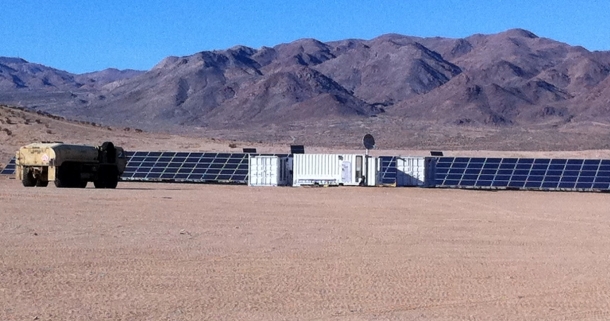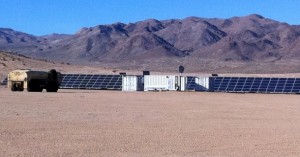by Martin LaMonica
The Army plans to install microgrids in Afghanistan as part of its mission to reduce its energy-related vulnerability in the field. A three-month experiment will deploy a system designed to use fuel more efficiency and pave the way solar and wind power in the field, the Army said earlier this week.
Right now, the Army uses diesel generators to power its bases. Transporting that fuel for generators and its vehicles comes at a significant financial and military cost as fuel convoys are often targets for attack.

A photo of the one-megawatt microgrid planned for Afghanistan during testing in California. (Credit: Dennis Simon/U.S. Army)
The microgrids the Army plans to install will include diesel generators that are able to communicate with each to dole out only the amount of power that’s needed, saving on fuel. The basis for one microgrid will be four generators able to produce one megawatt. That will replace 22 smaller units, a move that should make maintenance simpler and cut fuel use.
The microgrids will include controls to integrate power generated from solar panels and storage systems. One of the design goals for the Army over the long term is to have modular systems where different sources of power can be used without complex on-site engineering.
“They’re being designed so that a soldier can just hook them up any way and plug things in and not have to worry about doing prior analysis of how the power grid should be laid out or what load should be placed where,” said Chris Wildman, the Hybrid Intelligent Power program lead, in a statement. “The generators automatically talk to each other, recognize each other and can control each other without Soldier intervention.”
The target application for Army microgrids are bases that start small but grow rapidly and see a rapid increase in power demand. For its tests in Afghanistan, the microgrids will power non-essential operations, such as laundry and kitchens.
The U.S. military has already tested solar panels in Afghanistan as a way to cut down on diesel generators, solar-powered shade tents, and portable solar panels for soldiers on patrol, all of which is part of a strategy to minimize the amount money spent on fuel.
Last week, the Army opened a laboratory specifically to study how microgrids can use existing technologies to make camps more energy efficient.
Source: cnet

 Follow
Follow